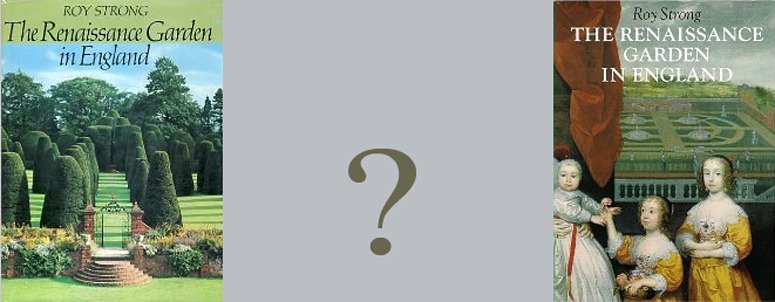I have been slow to review this book – the hardback (left) was published in 1979. The paperback (right) was published in 1998 with a statement from the author that ‘I intend to rework the whole subject, incorporating all that has happened in the last twenty years’. So my comments may be of use to the author.
(1) Put dates on the front cover
The present title may be compared to a book on The Great War in which you have to read half the first chapter to discover that it is really a book on The Great War 1914-16. Strong writes on page 13: ‘In this book I am only going to take one period and one thread. The period stretches from the accession of Henry VIII (1509) to the outbreak of the Civil War in 1642 and the thread is the evolution, design and meaning of the palace and the great garden’.
(2) Revise the book to include the century from until 1642-1742 (or more)
This is when Renaissance ideas had most influence on English gardens – as shown by Kip and Knyff’s topographic drawings. One could be disappointed in a book on The Second World War which only covered the period from September 1939 to the fall of France on 22 June 1940. As Kip and Knyff show in Britannia Illustrata, English gardens in 1707 were much more ‘Renaissance’ than ‘Baroque’. They had aignificant ‘Baroque’ aspect but it was never dominant. The avenues in the Kip and Kynff drawings half-hearted additions to fundamentally High Renaissance plans.
(3) Prefer the cover of the paperback edition, despite its parenticidal cropping (see the original)
As Roy Strong notes, on page 211, the garden of Packwood House (as used on the cover of the 1979 hardback edition) is ‘long famous as a garden planted in the 1660s, it was in fact, a mid-Victorian re-creation’. Apart from the question of it being a highly dubious ‘re-creation’, even the original is outside Roy Strong’s period
(4) Remove the book’s silly dedication
It reads ‘IN MEMORY OF ALL THOSE GARDENS DESTROYED BY CAPABILITY BROWN AND HIS SUCCESSORS’. The most significant Renaissance gardens discussed by Roy Strong are Hampton Court, Whitehall, Nonsuch, Kenilworth, Theobalds, Wollaton, Wimbledon, Richmond. Hatfield, Ham House, Worcester Lodge, Dowsby, Northampton House, Twickenham, Chastleton House, Gorehambury, Moor Park Herts, Wilton, Arundel House, Danvers House. A little historical investigation, aided by a pocket calculator, could reveal that >10% of these gardens fell victim to the landscape movement.


